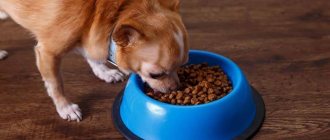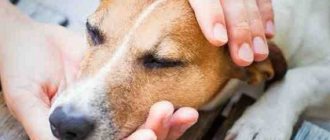If you notice that your dog is scratching his mouth and rubbing his muzzle, you may need to do a little investigating to find out why he is itching there. Although he may scratch to relieve the itching, constant scratching can cause injury and secondary bacterial infections on the skin. Constant scratching can also cause hair loss, sore and inflamed skin, and flaking and thickening of the skin.
These are the main reasons for this behavior, which can be completely harmless or endanger the life of our pet.
Signs of itching in dogs
Itching in a dog is a symptom of a disease.
Recognizing the problem is quite simple if you carefully pay attention to the behavior of your pet:
- The animal scratches and gnaws the skin in certain places.
- Scratching can lead to bleeding.
- Hair falls out in problem areas.
- The dog may whine while brushing.
- Appetite decreases.
- The fur becomes dull.
- The animal becomes lethargic and does not play its favorite games.
- Sores appear on the skin.
Note! If a dog bites the same place on the skin for several days in a row, this should be a reason to contact a veterinarian.
A sign that your dog is itching is sores on the skin.
Hair falls out
Sometimes the itching on the body is so severe that the pug scratches itself, which is called “to the meat.” The armpits are most often affected.
The reasons for such severe itching can be caused by the following abnormalities:
- subcutaneous mite, demodicosis. It moves under the skin, gnawing passages and causing unbearable itching;
- allergic reaction to flea bites;
- increased reaction to non-food components, for example, allergies to dust, flowering plants and the like, in other words, atopic dermatitis;
- food allergy.
Why does a dog itch and chew itself?
There are a large number of different reasons why a puppy or an adult dog itches. Only a veterinarian can identify them after examination and taking appropriate tests. Such problems can be encountered by both the owner of small dogs (for example, Spitz, Yorkie or Pekingese) and large ones. What could be the reasons if a dog is constantly itching?
Psychogenic causes (stress, fear)
When this problem occurs, psychogenic causes cannot be ruled out. Animals, like people, react to stress. Due to emotional stress, dogs may develop allergies, which are accompanied by itching. This behavior is extremely rare.
If there are no health problems, and the dog continues to scratch places on the skin and constantly lick, you need to analyze what has changed recently in its life and eliminate the factors that contribute to stress. For example, this could be the owner leaving on vacation, or the appearance of a new person in the house who offends the animal. This behavior can also begin due to the owner’s inattention to the pet or constant being alone at home.
Note! Itching due to psychogenic factors is most often found in shepherds, Dobermans, Labradors, and Great Danes.
Atopic dermatitis
Another reason why a dog itches a lot is atopic dermatitis. This is a chronic skin disease that occurs due to allergies. We can say that atomic dermatitis is a non-food allergy. It can arise due to anything. This includes dust in the house, plant pollen, and household chemicals.
The first symptoms of the disease appear between the ages of 3 months and 6 years. Moreover, in the first years it can manifest itself extremely weakly. In this case, the affected areas are the ears, muzzle, groin, armpits, eye area and between the fingers.
Atopic dermatitis
It is impossible to cure atomic dermatitis, since finding and eliminating the allergen can be problematic and sometimes impossible. In this case, the dog will need to be given lifelong treatment to relieve the symptoms.
Autoimmune pathologies
Another factor why a dog constantly itches and chews itself is autoimmune diseases. These include pemphigus complex, bullous pemphigoid, lupus erythematosus, VKH syndrome.
Treatment of these diseases is complex. The main goal of therapy is to promote the body's own immune response. Glucocorticosteroids are used for this purpose. If these drugs do not help, the treatment is changed.
Attention! If there are depigmented areas of the skin, it is not recommended to walk the dog outside to avoid burns. Otherwise, squamous cell carcinoma may develop.
Food allergies
The causes of itching in a dog may be due to food allergies. It also appears in the form of brown discharge in the ears, dry sores on the stomach and back, blackening of the skin in the groin area, scratching of the paws and other places until they bleed. The ears may stink if the allergy is caused by a fungus.
In this case, you need to reconsider your diet. Find out which product is an allergen and remove it from food. You may need to switch to a different type of food. You can also get an allergy shot.
If there is a food allergy, the dog is put on a special diet based on veterinary food. The duration of such a diet is up to 6-8 weeks. If allergy symptoms go away during a change in diet, then the problem really was in the food that the dog constantly ate. If the allergy does not go away, then you need to look further for what exactly is the allergen.
This is how food allergies manifest themselves
Infection with parasites, but not fleas
Your pet's skin may itch not only because of fleas, but also because of a number of other parasites. For example, these could be subcutaneous mites, lice eaters, lice or worms. In the case of mites, the whole body will itch. If the pet is infected with worms, then itching will be observed in the anus. Also, some animals, when infected with worms, roll on the carpet on their butts. In both cases, you should not try to choose medications on your own. You first need to determine what type of parasite is causing the problem, and then begin treatment.
Attention! Infection with parasites is a very dangerous problem, the untimely solution of which can lead to serious health problems and even death.
Dry skin
Dry skin can be considered a symptom of disease. There can be many reasons for this illness. Only a veterinarian can find out. There is no need to lubricate the skin with moisturizing lotions, as this will only mask the problem, but will not solve it.
Ticks
From spring to autumn, all dog lovers are united by one problem - how to protect their pets from ticks. After all, tick bites can be very dangerous. A few hours after the bite, itching may not always appear. Many dogs do not react to the parasite in any way, without noticing it. Therefore, after each walk you need to examine the dog, and even better, buy a collar, drops or anti-tick tablets in advance.
Additional Information! For more successful protection, it is better to combine two of these methods. For example, you can put on a collar and treat your pet with drops.
Side effects of medications
When a dog scratches its face and other parts of its body, this may be a side effect of the medications the animal is taking. If the situation is not critical and the animal does not scratch its skin until it bleeds, you can ignore it (especially if this side effect is indicated on the packaging). If your pet scratches its skin until it bleeds and becomes irritable, you need to stop giving medications and contact a veterinarian.
Contact with irritants
Allergic reactions in dogs can occur not only to food, but also to chemicals. For example, upon contact with detergents, shampoos or other household chemicals. If itching begins some time after washing your paws or bathing, then you need to change your dog’s shampoo.
Fungal dermatitis
Another reason why your dog itches is fungal dermatitis. The fungus causes baldness of parts of the body, severe itching, and scratching of the skin until it bleeds. The skin can become bald in any part of the body. The dog may whine when the itching becomes unbearable. The fungus needs to be treated as quickly as possible.
Fungal dermatitis
It is important to remember that the fungus spreads very quickly and without timely treatment contributes to a severe weakening of the animal’s immunity. If it appears in the ears, then without treatment it can lead to hearing loss.
Pathology of the sebaceous glands
Adenitis of the sebaceous glands is still poorly understood. The disease occurs either as a result of hormonal disorders, or is related to genetic diseases of dogs. Adenitis affects young animals and middle-aged dogs. This is a rare type of skin disease. In short-haired and smooth-haired breeds, adenitis occurs differently.
Its symptoms:
- Baldness of the sides, thighs and other parts of the body.
- Hair follicles become inflamed.
- White spots appear on the skin.
- The fur begins to fall off.
- Severe itching.
In short-haired breeds, purulent inflammations are less common.
Why does a puppy itch and why does a dog scratch his skin until it bleeds? Typically, dogs of all ages have the same health problems, so age does not play the most significant role in determining the cause.
Carrying out diagnostics
Diagnostic measures in a veterinary clinic traditionally begin with an external examination and medical history. In the vast majority of cases, an experienced specialist can, with a high degree of probability, determine the possible cause of scabies based on external signs, such as the nature of the skin lesion, its location, and the presence of accompanying symptoms. Subsequently , depending on the presumptive diagnosis, clarifying examinations are prescribed, for example:
- blood test - clinical, biochemical, for parasites, etc.;
- microscopy of skin scrapings and the contents of ulcers (allows us to identify not only ectoparasites, but also other pathogens);
- trichoscopy (computer examination of wool and fluff);
- cytological examination of skin or conjunctival scrapings;
- microscopic and cytological examination of wool, incl. using a tape test;
- Wood's lamp examination is a specific procedure for shining a dog in a dark room with a special optical device, which makes it possible to detect trichophytosis and some other types of pathogenic fungi on the animal's skin;
- X-ray examination of the jaw (if gingivitis and other problems with teeth and gums are suspected);
- measurement of intraocular pressure (to diagnose ophthalmological problems);
- histobiopsy is a complex study used in cases where “faster” methods for diagnosing the nature of dermatological pathology have failed.
Did you know? In Moscow, at the Mendeleevskaya metro station, there is a bronze monument to a stray dog scratching its own ear with its hind paw. The pedestal, called “Sympathy,” is dedicated to the memory of a stray dog named Boy, who lived nearby in an underground passage and was brutally killed in 2001.
The greatest difficulties usually arise from diagnosing an allergy, or more precisely, its causative agent. In this situation, the elimination method, in particular the so-called elimination diet, is still considered the most effective. Its principle is to gradually remove from the diet one by one all components that can cause allergies. Once the animal's condition has stabilized, potential irritants are returned to the feed in the same, one-by-one manner. These peculiar “swings” sometimes make it possible to quite accurately establish a pattern between scabies and the product that was eaten by the animal the day before.
What should the owner do if itching is detected?
If a dog scratches its face, nose, ears or other parts of the body constantly, and redness, sores appear in these places, and the skin peels, then you should immediately contact a veterinarian. Especially if this is a frequent occurrence.
Only a specialist can identify the cause. At the appointment, the doctor will examine the pet, take the necessary tests and ask the owner about diet, lifestyle and other details that may help identify the cause of the itching.
If the problem does not go away after the prescribed treatment, you need to contact the veterinarian again. This is the only way to help a dog. After visiting the doctor, you need to strictly follow the recommendations: change the diet if necessary, treat the affected areas, give your pet medications.
Note! If the dog has scratched its skin until it hurts, then you shouldn’t decide what to apply to the scratched areas yourself. This way you can only make the situation worse.
Possible causes of discomfort
Itching causes discomfort in the dog; it itches and pathogenic microorganisms and fungi can penetrate through the damage. The cause of itching can be:
- ectoparasites;
- allergic reaction of various etiologies;
- skin diseases;
- hyperfunction of the sebaceous glands;
- stress;
- systemic diseases - diseases of the reproductive system, malignant processes in the body, endocrine pathologies.
The owner of a dog can rarely independently determine the cause of itching; it is necessary to seek qualified help, since the disease can be caused by several reasons.
How to relieve your dog from itching
Itching itself causes dogs great discomfort. The animal becomes irritable, sleeps poorly and constantly itches. Even if the cause of the itching is not psychogenic, but physiological, if its solution is delayed, the animal may develop neurosis and mental disorders.
If your dog scratches his skin until it bleeds, it can cause him stress.
Only a veterinarian can relieve a dog of itching. It is better to contact the veterinary clinic in the morning, when the animal has had enough sleep. Additional tests may be required during the examination. After examining and receiving the results, the doctor will be able to come to a conclusion about what exactly is bothering the pet. Then he will prescribe the necessary treatment.
Important! It is worth noting that treating a dog is often a very expensive undertaking, so if a person is not ready to spend large sums on the health of his pet, it is better not to get one.
The treatment must be strictly followed. If the doctor has prescribed ointment, it is better to apply it at night, when the dog falls asleep. Usually dogs then try to lick off everything that was used on them, so after the procedure you need to sit with the animal for a few minutes and not let it lick the treated skin.
Hyperfunction of the sebaceous glands
Greasy tail in dogs
Some dogs exhibit a pathology called “greasy tail.” This pathology is more common in cats, but can also occur in dogs. Hyperfunction of the sebaceous glands, located like a rosary on the upper surface of the tail and around its base, leads to sticking of the hair, the formation of black spots on the skin, and the appearance of oily seborrhea. Itching causes the dog to chew its tail, “ride” on its butt, and causes severe discomfort. A dog's licking of affected areas can cause alopecia or serious tail injuries.
Treatment consists of treating the wool with special shampoos to regulate the function of the sebaceous glands. Until the cause of hyperfunction is determined, this is the only method.
Prevention
Prevention of itching means that you need to carefully monitor the dog’s health: treat the skin and fur from parasites, regularly deworm, and buy protective agents against ticks from spring to autumn. During the same period, the wool is treated for fleas. These procedures are necessary for all four-legged animals, even those who, for one reason or another, do not walk outside or communicate with other dogs.
It is also important to monitor your diet. Food allergies are one of the most common problems. Allergies can occur to anything, even meat. It is not recommended to overfeed an animal with one product. Including allergenic foods: citrus fruits, honey, chocolate, nuts.
Before getting a dog, you need to understand that you will have to bear responsibility for the animal. After all, having a pet means not only fun walks and games, it also means illnesses, regular treatments for parasites and taking care of its psychological state. If a person is not ready to face problems and solve them, it is better to abandon the idea of buying a dog.
Constantly touches his face
Sometimes owners notice that their pet has begun to scratch its face. At the same time, some pugs rub it with their paws, others scratch it on the carpet. There are many reasons for this behavior. Not everything is directly related to health.
- This may be a reaction to flea bites; first of all, the tender areas of the abdomen and face are affected;
- subcutaneous mites;
- dermatitis of various etiologies;
- the dog may try to free its mouth from stuck food;
- also the cause is discomfort due to dental problems;
- Stress also manifests itself as obsessive behavior.
If all causes have been ruled out or eliminated and the dog continues to itch, then your veterinarian may suspect a food allergy.
Main symptoms
Irritation in the groin is accompanied by the following symptoms:
- The appearance of inflamed, dry or weeping, flaky spots.
- Redness of the affected area, swelling.
- Severe itching. The dog scratches the sore spot, which aggravates the situation and leads to a secondary infection.
- Violation of the dog's behavior, irritability, anxiety, unmotivated aggression. If the affected area is painful, the dog does not allow it to be touched and may bite the owner.
- Temperature increase.
- Refusal of food.
- Increased thirst.
A sick animal tries to hide away from people, does not play, and behaves unusually passively.
Which breeds are more susceptible
Dogs with numerous skin folds, a tendency to obesity and short legs suffer more than others: Shar Peis, Pugs, Chow Chows, Pekingese, Dachshunds, Bulldogs (French and English).
The condition can affect any breed, but is especially common in puppies, older dogs, and animals with allergies.
Juvenile cellulite
Juvenile cellulitis is a disease of unknown etiology, characterized by inflammation of the subcutaneous tissue in puppies. The disease is rare. Mostly puppies are affected from 3 weeks of age to 4 months.
Symptoms:
- Swelling of the muzzle, usually painful.
- Swelling of the genitals, anus area.
— Subsequently, the hair around the eyes and on the chest begins to fall out.
— The mandibular lymph nodes become inflamed.
Most often, the puppy's eyelids, bridge of the nose, eyelids, chin, lips, and ear canal are affected. Sometimes other parts of the body are affected, the torso most often. The rash is painful, but the itching is not severe. The consequences of the disease are inflammation of the lymph nodes, purulent arthritis, and loss of appetite.
Treatment:
1. The disease is treated with drugs that are in the group of corticosteroids; doses are calculated individually and depend on the weight of the puppy. Prednisolone is the most commonly prescribed substance and is used orally for treatment.
2. Locally affected skin is not treated, since animals actively resist this process. If infected a second time, antibacterial treatment is carried out.
============================================================================================================================================================================================
Toothache
A sore tooth or other mouth pain may cause a dog to rub his face against something to relieve the pain. Dogs with toothache may eat less, want to eat only soft foods, or only chew on one side of their mouth.
Bad breath, bloody saliva, and repeated lip licking are other signs that may accompany muzzle rubbing in a dog that needs a tooth removed.
Some bad teeth may eventually fall out on their own, but this may take months or years and the dog will be in a lot of pain during this time.
Loose and broken teeth can also cause infection, which can affect organ function if left untreated.
Diseased teeth must be removed by a veterinarian, so medical attention is required if your dog rubs his face for this reason.











